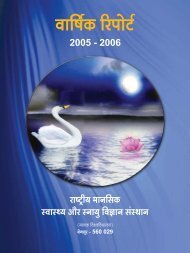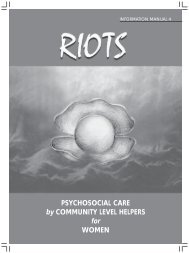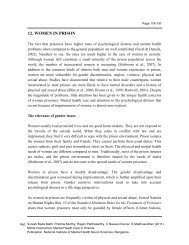An illicit alcohol production center in rural Bangalore - Nimhans
An illicit alcohol production center in rural Bangalore - Nimhans
An illicit alcohol production center in rural Bangalore - Nimhans
You also want an ePaper? Increase the reach of your titles
YUMPU automatically turns print PDFs into web optimized ePapers that Google loves.
Policies based solely on the pr<strong>in</strong>ciples of supply reduction, especially ones entrenched <strong>in</strong> the<br />
prohibition discourse are more likely to <strong>in</strong>crease the volume of undocumented <strong>illicit</strong> beverages<br />
be<strong>in</strong>g consumed. Apart from the obvious and immediate health consequences of toxic forms of<br />
<strong>alcohol</strong>ic beverages <strong>in</strong> widespread circulation, there is also the long-term consequence that such<br />
moves promote the flourish of crim<strong>in</strong>al black-market economies – a solution worse than the<br />
problem.<br />
As the f<strong>in</strong>d<strong>in</strong>gs from this study underl<strong>in</strong>e, the patterns of <strong>alcohol</strong> use <strong>in</strong> the country, leave no room<br />
for doubt that <strong>alcohol</strong> abuse and its consequences represents a serious and <strong>in</strong>cremental public health<br />
problem. Policy makers and health planners <strong>in</strong> India urgently need to plan and fund research and<br />
<strong>in</strong>terventions to deal with this impend<strong>in</strong>g epidemic.<br />
9. Critical aspects of study design<br />
Embedd<strong>in</strong>g the <strong>alcohol</strong> use questionnaire with<strong>in</strong> a general health assessment <strong>in</strong>creased the<br />
acceptance among the respondents. There were very few refusals, <strong>in</strong> fact they were less than one<br />
percent of all households approached.<br />
A screener was used to collect, basic socio-demographic data on the family, as well as screen for<br />
the presence of <strong>alcohol</strong> and tobacco use and any significant illness <strong>in</strong> the last year. This data was<br />
collected primarily from the head of household. Attempts were made to triangulate this <strong>in</strong>formation<br />
from other family members. Only family members thus nom<strong>in</strong>ated were approached to answer the<br />
detailed Individual questionnaire.<br />
Approach<strong>in</strong>g the head of household (usually male) ensured greater compliance among the other<br />
family members. However, this method, with h<strong>in</strong>dsight, we realized also contributed to under<br />
estimation of <strong>alcohol</strong> use among the younger males and the females <strong>in</strong> families. The male head of<br />
household, was likely to ‘protect’ the women and be ‘protected from the knowledge’ of <strong>alcohol</strong><br />
consumption <strong>in</strong> the younger males.<br />
Consequently, this method is also likely to have contributed to some underestimation of prevalence<br />
of <strong>alcohol</strong> use as a whole.<br />
The better but more time-consum<strong>in</strong>g option would certa<strong>in</strong>ly have been to approach all adult<br />
members of the family separately. But this study was designed as a rapid pilot study to determ<strong>in</strong>e<br />
the need for larger country-wide studies.<br />
The study provides a methodology to accurately assess the proportion of undocumented<br />
consumption <strong>in</strong> other parts of the country. The results certa<strong>in</strong>ly underl<strong>in</strong>e the need to conduct<br />
similar studies <strong>in</strong> the rest of the country.<br />
The door-knock<strong>in</strong>g assessment of type and quantity of use is an effective method for tapp<strong>in</strong>g the<br />
proportion of <strong>illicit</strong> <strong>alcohol</strong> use <strong>in</strong> a community. However, as mentioned earlier <strong>in</strong> the discussion,<br />
this method does not accurately gauge the proportion of “seconds” liquor be<strong>in</strong>g used by that<br />
community. The “seconds” beverages are not that much of a problem <strong>in</strong> most other parts of the<br />
country.<br />
The study also re-iterated observations from an earlier WHO Collaborative study <strong>in</strong> the same<br />
region, regard<strong>in</strong>g the widespread pattern of hazardous dr<strong>in</strong>k<strong>in</strong>g.<br />
Us<strong>in</strong>g the Human development Index to determ<strong>in</strong>e the first level of sample selection, we feel<br />
enabled a more accurate representation of the complex socioeconomic variation <strong>in</strong> the state, than<br />
merely factor<strong>in</strong>g <strong>in</strong> urban and <strong>rural</strong> representation. In the f<strong>in</strong>al analyses, the sample was<br />
representative of the male – female ratios <strong>in</strong> the state as well as broadly similar <strong>in</strong> terms of per<br />
capita <strong>in</strong>come.<br />
The study is <strong>in</strong>tended as a pilot for larger and more extended studies. India is a large country with<br />
wide diversity. This study highlights the need to expand the scope of this l<strong>in</strong>e of enquiry, <strong>in</strong><br />
different socio-cultural zones. Meanwhile, we feel that these results are compell<strong>in</strong>g enough to be<br />
used to advocate urgent and widespread public health approaches to the <strong>alcohol</strong> problem <strong>in</strong> India.<br />
87





